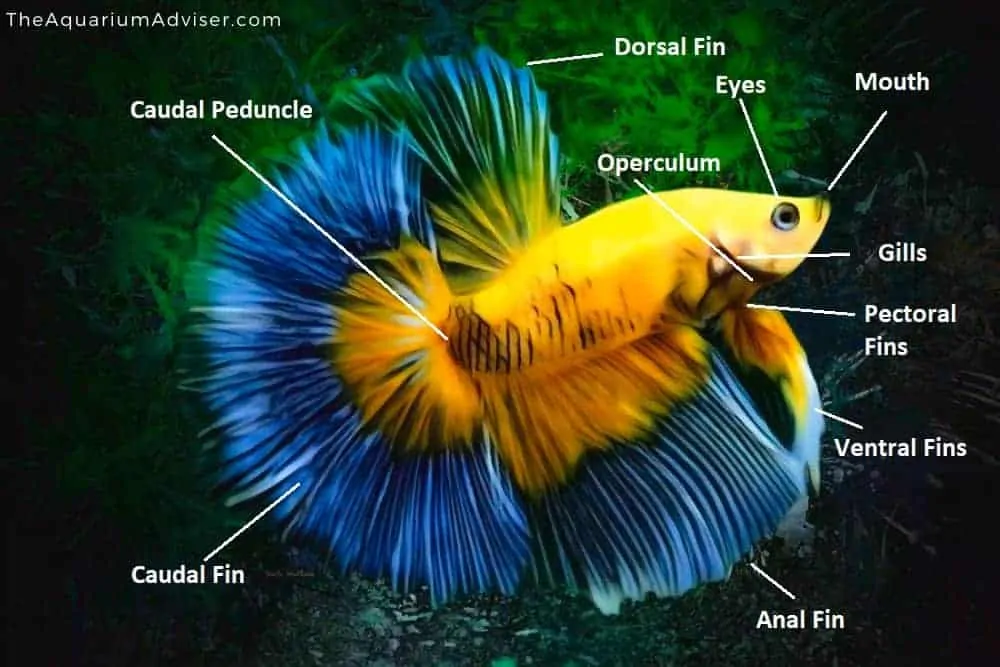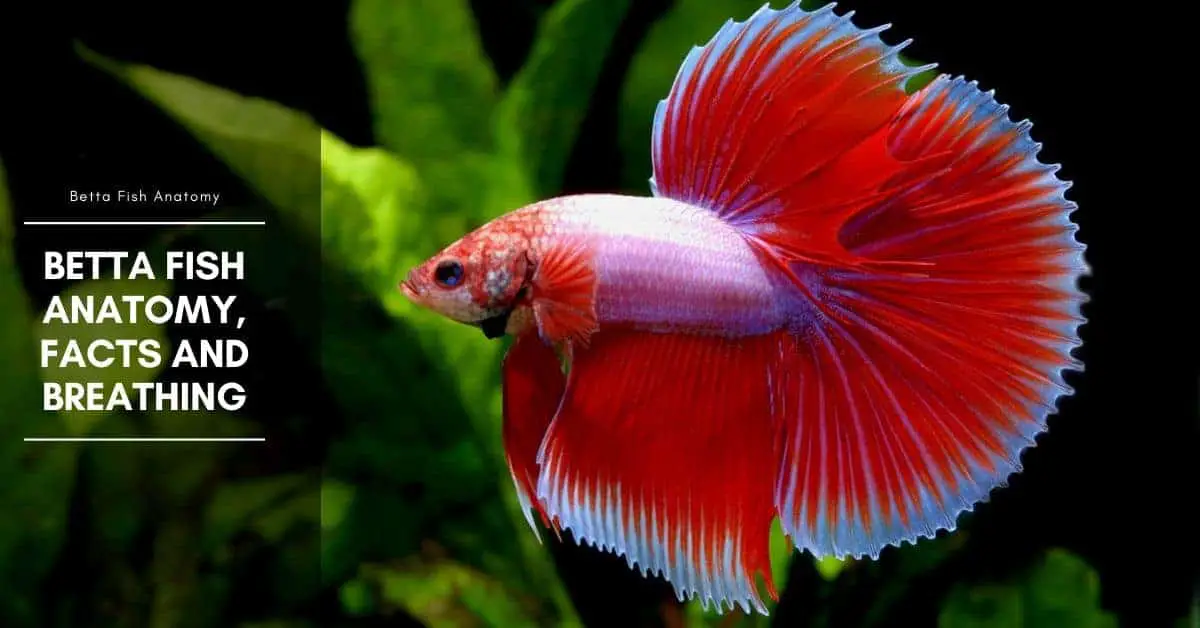It may seem like an exaggeration, however, knowing specific details about bettas including anatomy, facts, and breathing details will help you become a better caretaker. Gaining this knowledge will allow you to provide a great life for your fish pets. It is a sad sight, walking into pet sections of stores and seeing hundreds of betta stored into small cups, closely packed up next to one another.
Although they are “surviving” many are suffering in the conditions they are in. Only when you learn more about how the breed actually lives comfortably, can you understand how much stress they are under?
Anatomy of Betta Fish
At first glance, male and female bettas share many of the same anatomical features. Male bettas generally have a much flashier look and are larger than their female counterparts. Their bodies have a cylindrical form that tapers off to meet their “tail” fins (Caudal Fin). Betta have fish scales, which can be compared to armor which helps protect their soft internal organs. Healthy and happy bettas will display beautiful scales and colors on their body. If they are stressed or sick, you will notice their coloring is a lot duller and they can display dark horizontal lines along their body.

Mouth
Betta fish have quite a grumpy-looking face. This is because they have an upturned mouth that helps them suck in air and feed up at the surface. It also allows them to make bubble nests, which is how their offspring are able to be fertilized.
Here is something truly unexpected… betta fish have greater jaw strength than that of great white sharks. Yup, you read that right. The betta you have swimming in your tank, has a more powerful jaw than a great white (*by size proportion). Don’t worry though, although they have a lower jaw full of tiny sharp teeth, they cannot harm humans.
Betta are carnivores, and in the wild, they feed on different insects, larvae, and scraps larger animals leave behind. Their teeth assist in the breaking down of food before ingestion.
Eyes
Betta fish have 2 protruding eyes on each side of their head. They cannot blink and on close inspection, you will notice their iris (center of the eye) is black. Bettas have very good eyesight, as they are able to recognize their owners and can get agitated by their own reflections in a tank.
Dorsal Fin
Fins play an important role in keeping fish balanced and stabilized in water. This is no different with betta fish. Their dorsal fin is located on top of their bodies and can vary in shape and size depending on what type of betta it is. Just as with sharks and dolphins, betta uses their dorsal fin to travel in a straight line.
API STRESS COAT Aquarium Water Conditioner 16-Ounce Bottle
29% OffAPI STRESS ZYME Freshwater and Saltwater Aquarium Cleaning Solution 16-Ounce Bottle
API ACCU-CLEAR Freshwater Aquarium Water Clarifier 4-Ounce Bottle
12% OffCaudal Peduncle
The caudal peduncle refers to the thinnest section of a bettas body that connects to the caudal fin. It is simply the connection between the tail fin and the body.
Caudal Fin (Tail Fin)
The caudal fin is what propels a betta fish forward. Extensive breeding of betta has allowed for the creation of a great variety of fin sizes, shapes, and colors.
While the intense breeding of bettas has allowed for many magnificent tail fins to develop, it made them very different from their wild counterparts. Bettas bred to have long flowing tails are actually quite poor swimmers. Their fins are too long for their bodies and this makes them very easy prey in the wild. They are, however, gorgeous to observe in an aquarium.
Anal Fin
The anal fin is located underneath a bettas body. This is another fin that is perfectly positioned to help stabilize our fish in the water. Just as a boat uses a “keel” under its “body” or hull for stabilization, bettas have this naturally on their bodies.
Ventral Fins
The ventral fins are often also referred to as the pelvic fins. They can be quite long and thin depending on the type of betta and are located just below and behind the gills. The ventral fins of a male are much larger than those of a female.
These fins assist bettas in turning and stopping.
Pectoral Fins
These are the last 2 of the 7 fins bettas have. These fins are constantly in motion, helping guide a betta through the water. They can vary in size and color depending on the species of betta. Some owners refer to these fins as betta ears because of their flappy, ear-like appearance. They, of course, do not help bettas hear anything.
Operculum
The operculum is a shield that covers a bettas gills. Its job is simple, to protect a fish’s gills. While both male and female bettas have this protective shield, males have an extra membrane underneath there as well. This membrane is often referred to as a “beard” and allows us to more easily distinguish between a male and a female.
When betta want to look more intimidating, or when males show off a dominating dance, they flare up their entire bodies. This includes the operculum and, of course, their beards.
Gills
Betta have gills, which allows them to extract oxygen from water. This is one way that allows bettas to live and thrive, however, amazingly bettas can also thrive in low oxygenated water environments. Theirs gills alone would not allow them to survive in these conditions. Let’s see how they breathe in more detail below.
Breathing
Betta fish are definitely unique when it comes to their personalities and looks, but they also breathe in a very special way. As mentioned before, one way bettas breathe is how all fish breathe, with their gills. In simplest terms, fish will suck in water through their gills. As the water transfers through, the interior walls of the gills will absorb and remove the dissolved oxygen in the water. Oxygen is then transferred into the bloodstream and able to spread throughout the body. This is an amazing process that allows fish to live and thrive underwater.
Moving waters, like that in rivers and oceans, will constantly pick up oxygen from the air. This is great for fish as it’s how they breathe. In small, stagnant, warm waters, however, much of the oxygen will seep out. These conditions are lethal to most fish, but bettas can thrive in these environments.
How come?
If you already own a betta, you may have noticed that they sometimes come up to the surface for a bite of what appears to be nothing. You didn’t put any food in the tank, so what are they up there for? Well, it turns out that bettas can breathe directly from the surface of the water. They have something called a labyrinth organ. This organ allows them to transfer oxygen from their mouths into a format that their gills can process. A betta will grab some air with their mouth, pass it over the labyrinth organ, push it out through their gills, and this way transfer the oxygen into their bloodstream.
Having these two methods of breathing has allowed bettas to survive in small ditches, rice paddies, and puddles. It is important to realize that this is an adaptation for survival. Bettas can technically survive for a long time in a body of water only the size of a wine glass. This, however, does not mean they thrive and flourish in these poor conditions. Their adaptation allowed them to survive temporary conditions like a dry season. Some experts or betta breeders state, it is perfectly fine to keep a betta in glass or a cup, but this is incorrect. These should only be temporary environments.
A betta in your tank will still do most of it’s breathing underwater. However, if the tank has lower levels of oxygen, or if it feels like it, it will come up for a bite of fresh air.

Hi, my name is Sean, and I’m the primary writer on the site. I’m blogging mostly about freshwater and saltwater aquariums, fish, invertebrates, and plants. I’m experienced in the fishkeeping hobby for many years. Over the years I have kept many tanks, and have recently begun getting more serious in wanting to become a professional aquarist. All my knowledge comes from experience and reading forums and a lot of informative sites. In pursuit of becoming a professional, I also want to inspire as many people as I can to pick up this hobby and keep the public interest growing.
Read more about Sean.
Please join also my Facebook group.




















